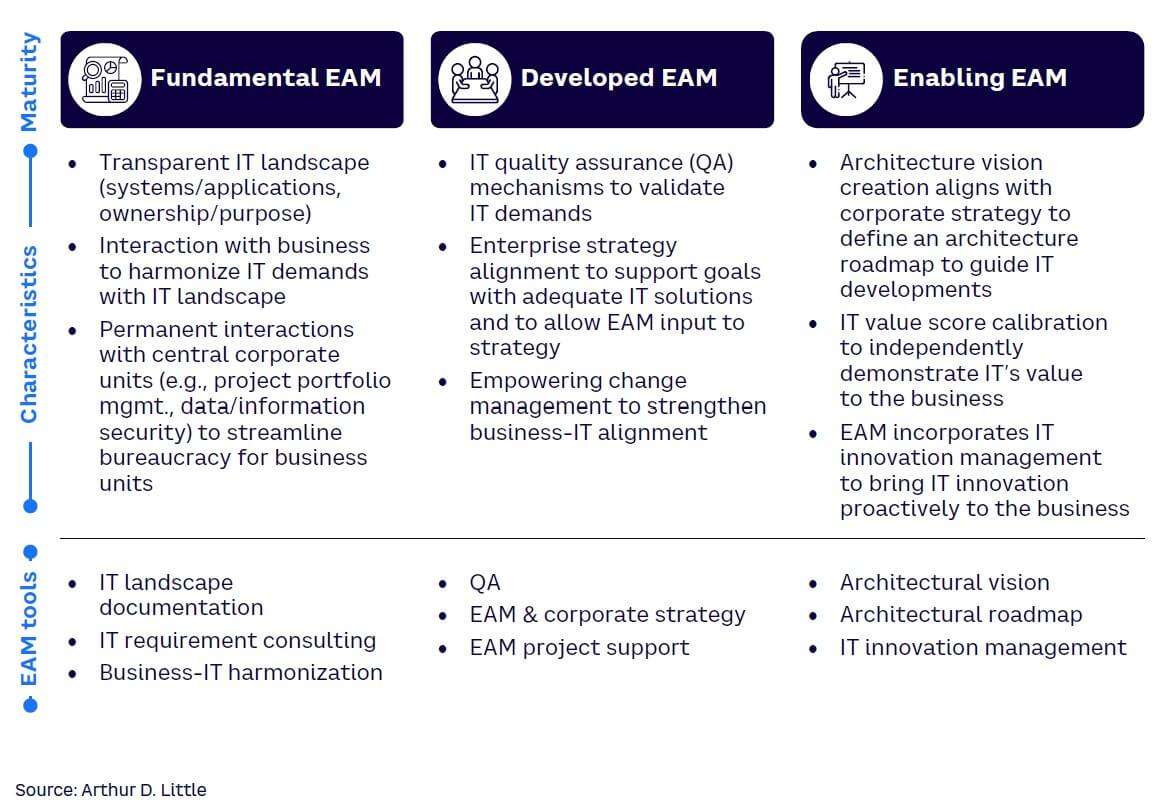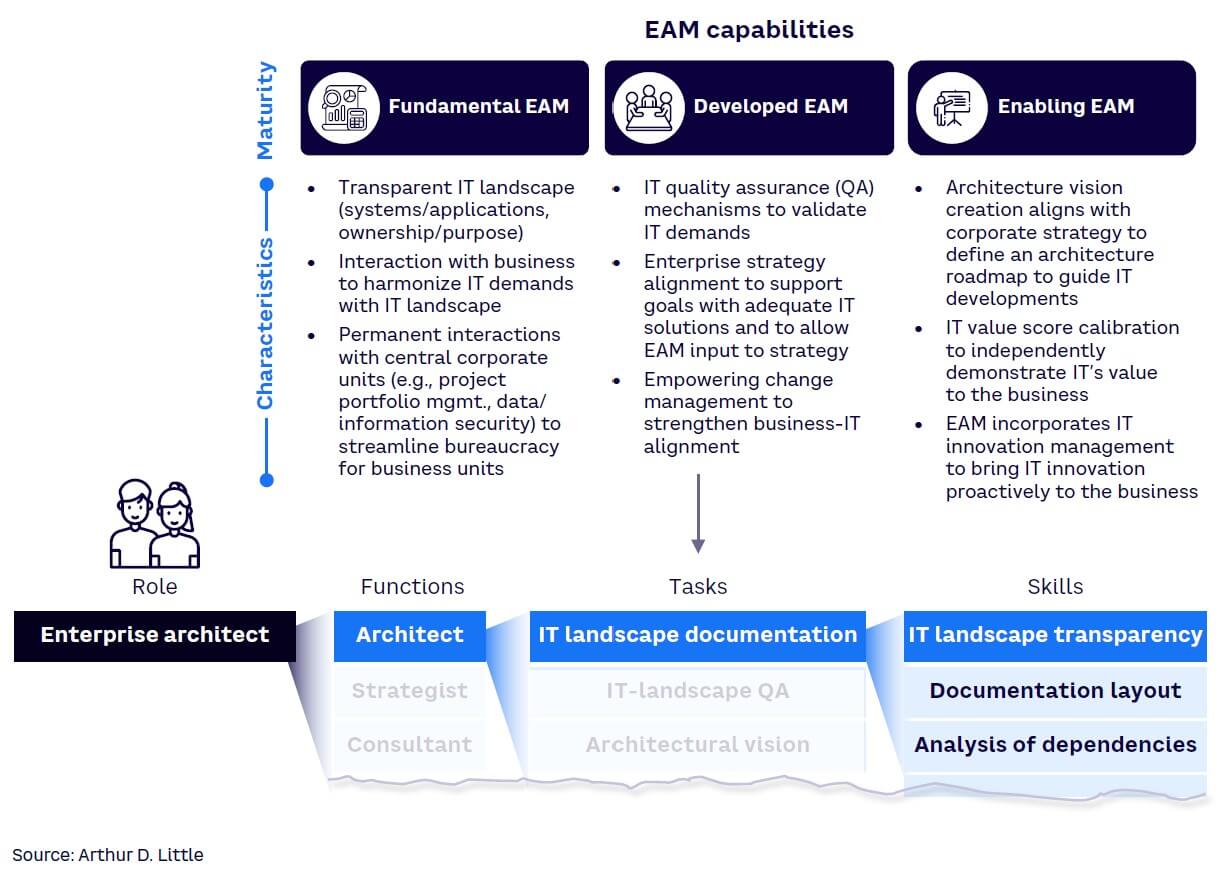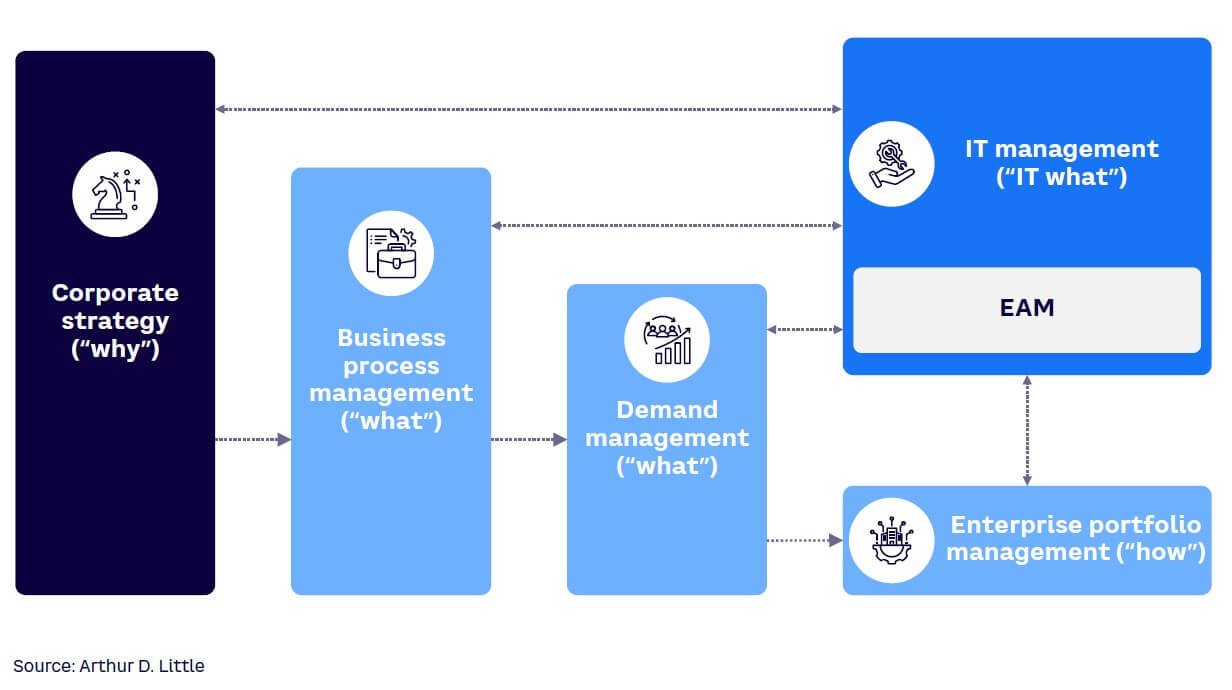
An organization’s enterprise architecture provides its technical IT backbone. Managing it effectively and strategically ensures that technology supports future business needs, driving innovation and efficiency while enabling transformation. However, enterprise architecture management (EAM) capabilities often do not have the level of focus and rigor required to support changing organizational requirements. This Viewpoint provides best-practice advice to transform EAM strategy and execution.
WHAT IS EAM?
Enterprise architecture management focuses on planning and administering an organization’s corporate IT landscape. Given that enterprise architecture underpins the entire digitized business, organizations should treat EAM as a strategic capability, delivering benefits around:
-
Optimized efficiency
-
Closer alignment between current business and IT needs
-
Greater innovation and the enablement of new business models through future-proofed architectures
HURDLES TO EAM SUCCESS
EAM should be at the heart of business-IT alignment. However, in practice, the discipline is often overlooked, with insufficient resources and/or focus on delivering transformative results. This is due to multiple factors, including:
-
Lack of communication and alignment between business strategy and IT planning
-
Lengthy nature of EAM decisions, where poor choices may only manifest over the long term, with potentially disastrous and escalating impact
-
The perception of many central EAM functions as bureaucratic obstacles that hit the brake on innovation, ultimately curtailing it
In reality, properly applied EAM acts as an accelerant, not a brake. Thus, companies should increase their focus on the discipline. Current EAM maturity levels are across a wide range, as these examples demonstrate:
-
An energy provider positioned its EAM function as a cost center with no interaction with the wider business. Consequently, it was viewed as not adding value and thus ignored as much as possible by divisional IT teams. As a result, there was no overall view of the company’s IT landscape, leading to duplication of IT solutions and added costs.
-
The EAM of an international transportation company was reactive rather than proactive, expecting business units to provide their architectural requirements. This resulted in a heterogenous, locally documented IT landscape, where holistic decision-making was impossible. Synergies, white spots, and redundancies were present but not visible to the organization.
-
An energy network operated EAM within the CIO function, as a subdivision of human resources. Yet every CIO capability (including EAM, portfolio management, and data security) had its own approach for business alignment, increasing bureaucracy and hindering understanding. The EAM function was sidelined and focused solely on developing theoretical EAM capabilities and IT landscape optimizations.
-
A mobility service provider operated with a central IT function, but its EAM team was understaffed, underdeveloped, and did not have an active role in any business process. Its reactive nature led to IT solution duplication and a failure to meet the requirement from senior management for an architectural vision and roadmap.
DEFINING EFFECTIVE EAM
The challenges outlined above are diverse; thus, EAM strategies need to be tailored to specific circumstances of company requirements. There are four characteristics at the heart of effective EAM: (1) transparency, (2) capabilities and maturity, (3) enterprise architects, and (4) business-IT alignment.
Transparency
EAM should provide a transparent picture of both the current and future enterprise architecture. This picture should be based on a structured approach that aggregates all organizational and procedural information with system/application-specific data, such as data involving business criticality, maintenance efforts, and number of active users. The resulting analysis — showing gaps, potential synergies, or opportunities for optimization — should be in-depth in order to drive a cohesive architectural development roadmap.
Capabilities & maturity
To be effective at a basic level, EAM must cover a minimum set of capabilities. At a foundational level, it needs to provide a high-level view of the current IT landscape with an up-to-date understanding of business needs. Further capabilities (such as the architectural vision) should then be added as the function matures. Figure 1 outlines how to structure EAM capabilities based on maturity levels in order to continually strengthen the EAM function and increase its business recognition.

These additional capabilities can be activated through EAM processes or tools, which provide a transparent structure that demonstrates value to the business. This is vital to changing internal views of the EAM function, shifting it from a bureaucratic cost center to becoming business-critical, empowering the EAM team to fulfill its role and design an effective development roadmap. This requires two success factors: (1) enterprise architects and (2) business-IT alignment.
Enterprise architects
Successful EAM is driven by a team that harmonizes business/corporate understanding with architectural expertise. Sophisticated technical skills alone do not deliver value if they are not applied in a business context. Enterprise architects therefore need to possess various soft skills, such as corporate cultural fit, business awareness, and persuasiveness. These must be combined with hard skills based on EAM processes and tools, including analytics, IT solution creation, and IT landscape awareness. All this should focus on the EAM development roadmap. These capabilities are outlined in Figure 2, which shows the functions and skills required to deliver IT landscape documentation; see also, sidebar “Case study — Soft skills enhancement.”

Business-IT alignment
As one area within the CIO function, EAM needs to harmonize with other IT capabilities (e.g., IT project portfolio management and data security) to enable holistic, solution-driven IT support of business requirements. Fewer, more streamlined interfaces with the business help change the image of EAM away from being overly bureaucratic to a more value-adding IT function.
Integrating EAM into corporate processes allows it to anticipate and continuously support business requirements. Its role can vary from consulting to active participation in formulating these needs. The sooner EAM becomes involved in the planning process, the stronger its enabling effect. Close interaction between EAM and portfolio management provides additional business value, as insights into planned and ongoing IT requirements can be analyzed in the background by the EAM team. This requires relatively low effort for the business and creates the opportunity for EAM to proactively present its recommendations to the business. Figure 3 illustrates an ideal model of aligning business and IT; see also, sidebar “Case study — Listening to the business.”

RECOMMENDATIONS FOR EAM SUCCESS
The four characteristics listed above underpin the creation of an effective EAM program. To achieve this, businesses should follow four key recommendations; these deliver a combination of long-term advantages and quick wins that create management buy-in and momentum to develop the EAM program:
-
Strengthen your IT landscape transparency and EAM capabilities. To begin, businesses need to better understand both the current IT landscape and business demands. Companies should use a step-by-step approach to build transparency of IT across the organizational structure. Information should be collected through research, workshops, and questionnaires, providing the chance to gain buy-in from business units by highlighting quick-win IT synergies and overlaps. Achieving IT landscape transparency is mandatory to bringing theoretical enterprise architecture principles to life.
-
Integrate EAM with business processes. EAM must then be integrated and aligned with the business, ensuring full and current knowledge of corporate strategy and goals as well as close involvement in decision-making processes. Executives can achieve this by implementing regular, focused alignment between EAM and the business. Early involvement in corporate decisions delivers the greatest value and requires enterprise architects to have the skills to engage with other departments on a business level, rather than being seen as bureaucratic blockers. If these skills are missing, companies must put in place training to develop them quickly and effectively.
-
Enhance EAM as IT innovator. After aligning with the business, executives should encourage and incentivize EAM to contribute to innovation. The aim is to offer innovative solutions for existing problems or ideas for implementing the latest technological advances. Depending on the goal, optimizing your IT landscape can deliver both disruptive innovation or more incremental changes that improve IT quality or reduce costs. In terms of radical innovation, a mature EAM function that is well integrated and aligned with the business can highlight opportunities for major change through technology that the organization itself is unaware of. For example, a well-developed EAM function can track and evaluate use cases for emerging technologies like the Internet of Things (IoT), artificial intelligence (AI), and machine learning (ML); map them back to the business model; and then identify how they can create opportunities, thereby adding value through strategic technology integration. Moreover, well-organized and agile EAM capabilities can enable the company to quickly adapt to new trends and changes in the market.
-
Drive business change with IT. Lastly, companies can enable EAM to manage IT-driven change. Business requirements and solution capabilities change rapidly but are not necessarily in step. That provides the opportunity for EAM to participate in the selection of potential IT solutions, analyzing opportunities and using its architectural roadmap and knowledge of business capabilities to deliver increased business value.
HARNESSING 3 BENEFITS OF EAM
The four recommendations highlighted above deliver multiple business improvements, headed by three key benefits: (1) enhanced IT quality, (2) IT cost reduction, and (3) innovation.
Enhanced IT quality
Well-structured EAM brings transparency to the current IT landscape. This enables companies to enhance IT quality by analyzing factors such as application/system usage (user frequency), solution stability, or landscape harmony and then acting on the results. Standardizing analysis allows businesses to utilize automated, constantly running, rule-based tools to highlight potential opportunities. EAM can also actively contribute to strategic goals by designing an architectural vision and roadmap that enables transparent IT transformation upon request. By providing this “single (and reliable) source of truth” EAM underpins wide-reaching architecture decisions, guaranteeing business impact. Additionally, by setting and providing architectural rules and guidelines to the rest of the organization, EAM delivers sufficient flexibility to meet individual business unit needs, such as by setting thresholds for EAM involvement as well as the degree of choice around “as-a-service (aaS)” applications or automation technologies.
IT cost reduction
Heterogenous IT landscapes are created when dynamic IT requirements combine with a lack of visibility on what solutions currently exist in the business. This potentially leads to duplication and increased costs. As well as using the enterprise architecture roadmap to support business requirements, EAM can monitor existing IT solutions in terms of their actual utilization, reliability, flexibility, and long-term business impact. This visibility enables the EAM function to identify synergies, white spots, redundant systems, unused licenses, and opportunities to optimize portfolios and deliver cost reductions. Through its analysis, EAM supports the shift from current bespoke solutions to those based on proven standards and platforms, offering further opportunities for cost reduction.
Innovation
A well-designed EAM function enables IT innovation, and depending on its maturity, can even facilitate innovation throughout the business. As EAM should have (near-)perfect information about the existing IT landscape combined with access to data from across the business, it is ideally placed to identify and drive both IT and broader innovation. At a minimum, EAM can recognize gaps and recurring issues throughout the business and offer solutions for improvement.
More importantly, a mature, business-aligned EAM function brings together detailed knowledge of overall corporate strategy with a vision of future trends. This can help shape the IT project portfolio toward breakthrough innovation by demonstrating possibilities and generating new ideas. For example, it could highlight how the integration of IoT technologies enables the business to act on real-time insights. In this case, EAM would integrate the technology based on business needs, capture and analyze data, and provide results to the business in the desired format. Similarly, EAM can enable organizations to implement new technologies like AI and ML.
Additionally, a well-developed EAM program can ensure that IT adapts to new requirements around innovation, rather than acting as an obstacle to change. For example, reducing the complexity and co-dependencies of the IT infrastructure lessens barriers to innovation across all areas of business. EAM therefore creates an environment where innovation and change is both feasible and possible. This enables the organization to more easily embrace the latest technological trends to provide better services and products and remain competitive and profitable.
Conclusion
EAM — A strategic backbone for change
Creating and developing the right enterprise architecture is crucial to accelerating digitization and adopting new technologies, such as IoT and AI. Once a certain capability level is in place, EAM can automatically generate business benefits. Corporate EAM should therefore:
-
Be treated as a strategic imperative, with increased top-down focus.
-
Start by creating a transparent, holistic view of the existing architecture.
-
Work closely with the business to understand current and future needs across divisions.
-
Put in place the right skills and resources at a foundational level to enable quick wins.
-
Ensure that architects have business as well as technical capabilities.
-
Develop the program over time to mature the EAM function to enhance IT quality, reduce costs, and enable innovation.



